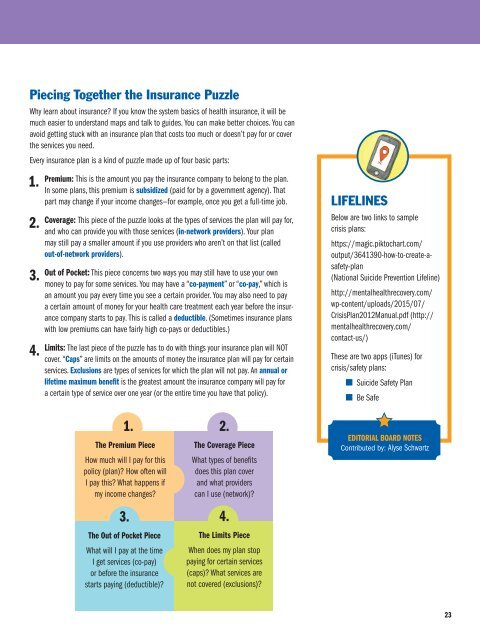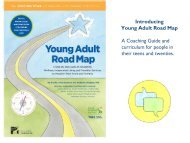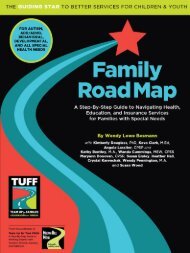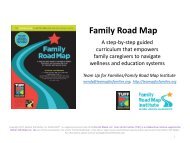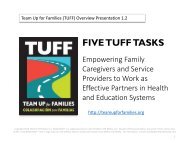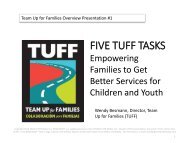Look Inside Young Adult Road Map
Create successful ePaper yourself
Turn your PDF publications into a flip-book with our unique Google optimized e-Paper software.
Piecing Together the Insurance Puzzle<br />
Why learn about insurance? If you know the system basics of health insurance, it will be<br />
much easier to understand maps and talk to guides. You can make better choices. You can<br />
avoid getting stuck with an insurance plan that costs too much or doesn’t pay for or cover<br />
the services you need.<br />
Every insurance plan is a kind of puzzle made up of four basic parts:<br />
1.<br />
2.<br />
3.<br />
4.<br />
Premium: This is the amount you pay the insurance company to belong to the plan.<br />
In some plans, this premium is subsidized (paid for by a government agency). That<br />
part may change if your income changes—for example, once you get a full-time job.<br />
Coverage: This piece of the puzzle looks at the types of services the plan will pay for,<br />
and who can provide you with those services (in-network providers). Your plan<br />
may still pay a smaller amount if you use providers who aren’t on that list (called<br />
out-of-network providers).<br />
Out of Pocket: This piece concerns two ways you may still have to use your own<br />
money to pay for some services. You may have a “co-payment” or “co-pay,” which is<br />
an amount you pay every time you see a certain provider. You may also need to pay<br />
a certain amount of money for your health care treatment each year before the insurance<br />
company starts to pay. This is called a deductible. (Sometimes insurance plans<br />
with low premiums can have fairly high co-pays or deductibles.)<br />
Limits: The last piece of the puzzle has to do with things your insurance plan will NOT<br />
cover. “Caps” are limits on the amounts of money the insurance plan will pay for certain<br />
services. Exclusions are types of services for which the plan will not pay. An annual or<br />
lifetime maximum benefit is the greatest amount the insurance company will pay for<br />
a certain type of service over one year (or the entire time you have that policy).<br />
Lifelines<br />
Below are two links to sample<br />
crisis plans:<br />
https://magic.piktochart.com/<br />
output/3641390-how-to-create-asafety-plan<br />
(National Suicide Prevention Lifeline)<br />
http://mentalhealthrecovery.com/<br />
wp-content/uploads/2015/07/<br />
CrisisPlan2012Manual.pdf (http://<br />
mentalhealthrecovery.com/<br />
contact-us/)<br />
These are two apps (iTunes) for<br />
crisis/safety plans:<br />
n Suicide Safety Plan<br />
n Be Safe<br />
1.<br />
The Premium Piece<br />
How much will I pay for this<br />
policy (plan)? How often will<br />
I pay this? What happens if<br />
my income changes?<br />
3.<br />
The Out of Pocket Piece<br />
What will I pay at the time<br />
I get services (co-pay)<br />
or before the insurance<br />
starts paying (deductible)?<br />
2.<br />
The Coverage Piece<br />
What types of benefits<br />
does this plan cover<br />
and what providers<br />
can I use (network)?<br />
4.<br />
The Limits Piece<br />
When does my plan stop<br />
paying for certain services<br />
(caps)? What services are<br />
not covered (exclusions)?<br />
Editorial Board Notes<br />
Contributed by: Alyse Schwartz<br />
23


